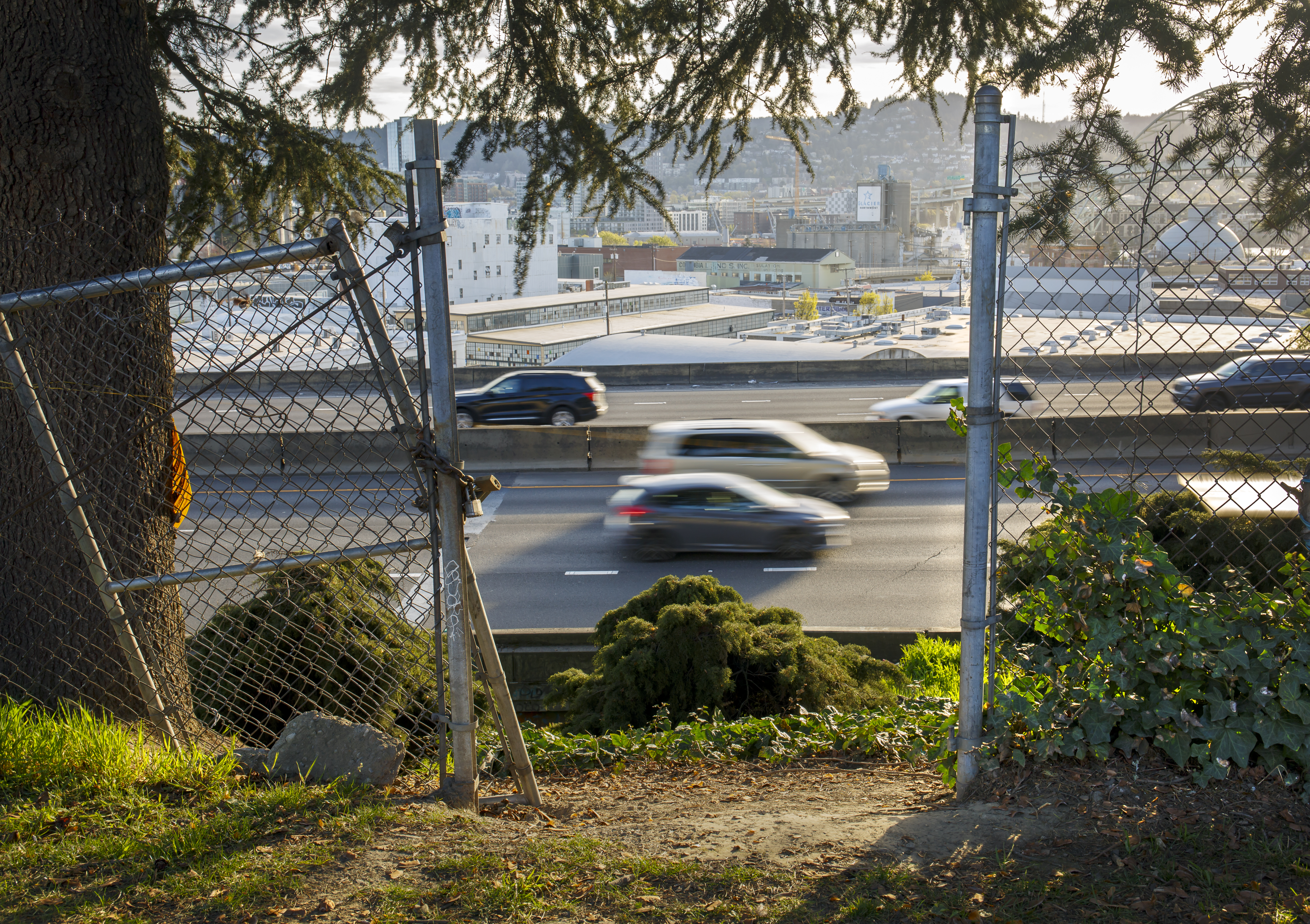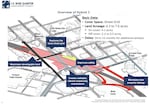
The I-5 freeway is seen through the fencing at the back of Harriet Tubman Middle School in North Portland, April 9, 2021. ODOT's proposed Rose Quarter expansion would bring the freeway even closer to the school grounds.
Kristyna Wentz-Graff / OPB
The Oregon Transportation Commission granted conditional approval on Thursday for a path forward to renovate and widen Interstate 5 through the Rose Quarter corridor, as well as cap the freeway and allow for redevelopment of the former Albina district.
The commission’s unanimous decision follows the recommendation of Gov. Kate Brown last month that the Oregon Department of Transportation pursues “hybrid option 3.” That plan would essentially tunnel the freeway and provide economic opportunity for the region’s Black community in an effort to reclaim the Albina district.
Members of ODOT committees such as the Historic Albina Advisory Board and other stakeholder groups have consistently voiced their opinion favoring a project that focuses on restorative justice. Supporters say the idea behind this project model is to remediate historic harm caused by the freeway’s original construction and displacement of community members.
Approval of the hybrid 3 model is contingent upon ODOT providing a thorough analysis of the project’s cost structure and funding sources by December. It would also require ODOT and its contractors to update its diversity and subcontracting plans, as well as to reevaluate the project’s initial environmental impact study.
The commission’s decision followed a brief update on the project’s progress and regional planning work by ODOT’s staff including Rose Quarter Improvement Project Manager Megan Channell.
Channell delved into the specific details of how hybrid 3 varies from the original concepts of the I-5 Rose Quarter expansion.

A proposal for the I-5 Rose Quarter improvement project with three main modifications from previous design concepts, intended to reconnect the local street grid and support neighborhood access and environments.
Via I-5 Rose Quarter Improvement Project
The largest difference is that the new model would produce a singular cap over the freeway instead of two separate caps proposed in the initial concept. Construction would be pushed back to begin in late 2023 with minor preparation work beginning earlier.
The cap would create a freeway tunnel through the Rose Quarter, relocate ramps to accommodate the cap and restore the street grid above. It would also remove some current pedestrian and bike links across the freeway and shift them to other streets.
The proposed cap would allow for light development on top of the freeway capable of holding buildings of up to three stories. It could be strengthened to accommodate up to six-story buildings.
“We heard that a successful highway cover design really is defined as one that brings investment into and provides long-term benefits to the Historic Albina community,” Channell said. “Also that access and safety would be provided for people walking, biking, driving and using transit for within and through the project area.”
The project’s cost has risen significantly from its initial price tag of between $715-795 million to upwards of $1.18 billion. The project could top $1.4 billion if a more robust cap over the freeway was pursued to allow heavier development.
Questions remain over where the state will find money to close the funding gap created by this iteration of the project.
The Oregon Legislature carved out $30 million annually for regional mobility projects in a 2017 transportation package that could be used for this project, but ODOT’s finance and revenue team is currently vetting options to make up the difference through bonding and use of future federal infrastructure dollars.
A regional tolling program is also in the works that would provide the state the ability to bond against toll revenue in order to help pay for the project and others. Tolls would vary throughout the day to put a price on congestion, aiming to get drivers to change their behavior and take fewer trips during peak traffic hours.
Travis Brouwer, ODOT’s assistant director of revenue and finance, told the commission that at current interest rates, the state could theoretically raise between $500 million and $700 million in bond revenue.
Vice Chair Alando Simpson and Commissioners Sharon Smith and Julie Brown all raised concerns about the price tag for creating new developable land. Under the hybrid 3 concept, the state would pay more than $400 million to produce just four aces.
“$455 million yield leads to $6,037 per square foot, and that’s just for land,” Simpson said. “I don’t know in what other city those costs are normal. I would assume that in some massive, international cities, they are. But I think that’s probably unheard of for Oregon standards.”
Brown said she wants to find out sooner than later what is realistic for Oregon in this project and where the community can give some concessions — particularly in the strength of the caps allowing different levels of development on top — in order to bring the price down.
Smith questioned the overall viability of the project and asked her colleagues whether they believe Oregonians would approve the project if it were put on the ballot.
“Do you want to spend $1.5 billion on a road project? Is that the best use of our public funds right now? And I don’t know if the answer would be yes,” she said.
Commissioners also expressed frustration that they feel the responsibility to focus this project on restorative justice is falling solely on the shoulders of ODOT and the commission when the City of Portland, Multnomah County, State of Oregon and federal government were all involved in the decision to place I-5 where it is today and displace the Albina community.
Simpson said he hopes to see those other governments and agencies stepping up and coming to the table in terms of the role they play in bringing the restorative justice aspect of the project to fruition, as the price continues to rise.
“This was not just ODOT’s doing to the Black community,” Simpson said. “I will say that as a Black resident, as a fourth-generation Portlander who has a great grandfather who invested a lot of time in this Albina community. It was not ODOT only.”





